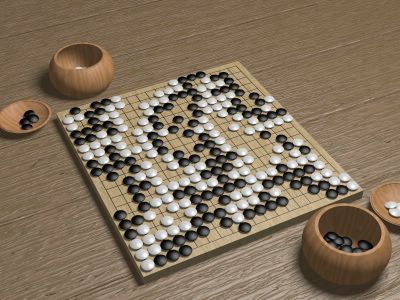Although rules of Go can be written so that they are very simple, the game strategy is extremely complex. Go is a perfect information , deterministic , strategy game , putting it in the same class as chess , checkers (draughts), and reversi (othello). It greatly exceeds draughts and reversi in depth and complexity, and transcends even the complexity of chess. Its large board and lack of restrictions allows great scope in strategy. Decisions in one part of the board may be influenced by an apparently unrelated situation in a distant part of the board. Plays made early in the game can shape the nature of conflict a hundred moves later.
The game emphasizes the importance of balance on multiple levels, and has internal tensions. To secure an area of the board, it is good to play moves close together; but to cover the largest area one needs to spread out. To ensure one does not fall behind, expansionist play is required; but playing too broadly leaves weaknesses undefended that can be exploited. Playing too low (close to the edge) secures insufficient territory and influence; yet playing too high (far from the edge) allows the opponent to invade. Many people find the game attractive for its reflection of the contradictory demands found in real life.
The game complexity of Go is such that even an introduction to strategy can fill a book, and many good introductory books are available. Go strategy and tactics gives a very brief introduction to the main concepts of Go strategy.
It is commonly said that no game has ever been played twice. This may be true: On a 19?19 board, there are about 3361?0.012 = 2.1?10170 possible positions, most of which are the end result of about (120!)2 = 4.5?10397 different (no-capture) games, for a total of about 9.3?10567 games. Allowing captures gives as many as
possible games


No comments:
Post a Comment